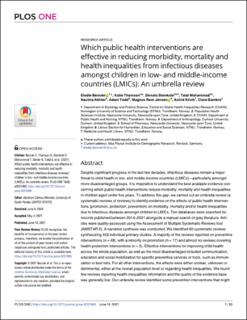| dc.contributor.author | Besnier, Elodie | |
| dc.contributor.author | Thomson, Katie | |
| dc.contributor.author | Stonkute, Donata | |
| dc.contributor.author | Mohammad, Talal | |
| dc.contributor.author | Akhter, Nasima | |
| dc.contributor.author | Todd, Adam | |
| dc.contributor.author | Jensen, Magnus Rom | |
| dc.contributor.author | Kilvik, Astrid | |
| dc.contributor.author | Bambra, Clare | |
| dc.date.accessioned | 2021-10-26T07:19:15Z | |
| dc.date.available | 2021-10-26T07:19:15Z | |
| dc.date.created | 2021-05-25T13:31:44Z | |
| dc.date.issued | 2021 | |
| dc.identifier.issn | 1932-6203 | |
| dc.identifier.uri | https://hdl.handle.net/11250/2825510 | |
| dc.description.abstract | Despite significant progress in the last few decades, infectious diseases remain a major threat to child health in low- and middle-income countries (LMIC) - particularly amongst more disadvantaged groups. We need a clear overview of the effectiveness of public health interventions in reducing morbidity, mortality and health inequalities in children aged under 5 years. To address these gaps, we carried out an umbrella review (a systematic reviews of reviews) to identify evidence on LMIC countries. The reviews of interest described the effects of public health interventions (promotion, protection, prevention) on morbidity, mortality and/or health inequalities due to infectious diseases amongst children. Ten databases were searched for records published between 2014-2019 alongside a manual search of gray literature. Articles were quality assessed using the Assessment of Multiple Systematic Reviews tool (AMSTAR 2). A narrative synthesis was conducted. We identified 41 systematic reviews synthesizing 322 individual primary studies. A majority of reviews reported on preventive interventions (n=30) with a minority on promotion (n= 11), but almost no reviews covering health protection interventions (n=1). Effective interventions for improving child health across the whole population, as well as the most disadvantaged included communication, education and social mobilization for specific preventive services or tools, such as immunization or bed nets. For all other interventions, the effects were either unclear, unknown or detrimental, either at the overall population level or regarding health inequalities. We found few reviews reporting health inequalities information and the quality of the evidence base was generally low. Our umbrella review identified some prevention interventions that might be useful in reducing under five mortality from infectious diseases in LMICs, particularly amongst the most disadvantaged groups. | en_US |
| dc.language.iso | eng | en_US |
| dc.publisher | Public Library of Science | en_US |
| dc.rights | Navngivelse 4.0 Internasjonal | * |
| dc.rights.uri | http://creativecommons.org/licenses/by/4.0/deed.no | * |
| dc.title | Which public health interventions are effective in reducing morbidity, mortality and health inequalities from infectious diseases amongst children in low- and middle-income countries (LMICs): an umbrella review. | en_US |
| dc.type | Peer reviewed | en_US |
| dc.type | Journal article | en_US |
| dc.description.version | publishedVersion | en_US |
| dc.source.journal | PLOS ONE | en_US |
| dc.identifier.doi | 10.1371/journal.pone.0251905 | |
| dc.identifier.cristin | 1911714 | |
| dc.relation.project | Norges forskningsråd: 288638 | en_US |
| cristin.ispublished | false | |
| cristin.fulltext | original | |
| cristin.qualitycode | 1 | |

